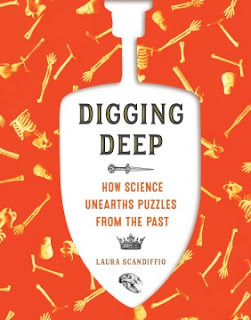I never expected to be wowed by a book on archeology, but as soon as I read this I put it on my "must-purchase" list and am eagerly looking for families to suggest it to as I write!
An introduction explains how archaeologists research the past and how science has changed the way they do this as well as given new views of older discoveries. The book itself tackles six fairly well-known archaeological finds (well, I knew about them anyways - I've started discounting anything as well-known or even known at all). The first is the prehistoric man found in the alps in 1991, named Otzi the Iceman. Research continued to produce new knowledge about Otzi's life and time period, up to the present day, when scientists were able to use new DNA techniques to discover more about Otzi's life. The chapter ends with a section labeled "What we thought we knew... and what we know now" which summarizes the original find and research and how it's changed through new scientific advances.
Each of the following chapters follows the same structure as they explore a Stone Age cave in South Africa where they find what may be the oldest poison (this one was new to me) in 1940, lost cities in Cambodia discovered through lidar, the shipwrecks of the Erebus and Terror in the Arctic, the mystery of the death and missing grave of Richard III, and Chauvet cave in France, where some of the earliest prehistoric art was discovered. This book gives readers a new view of science - and history - challenging old ideas about indigenous, non-Western societies, exploring the ways science changes the way we think, and encouraging readers to look forward to new discoveries and their own research and exploration.
Back matter includes sources, further reading, an index, and image credits.
Verdict: A unique and scientific look at history, archeology, and research. Highly recommended.
ISBN: 9781773212395; Published April 2019 by Annick Press; Borrowed from another library in my consortium; Purchased for the library
An introduction explains how archaeologists research the past and how science has changed the way they do this as well as given new views of older discoveries. The book itself tackles six fairly well-known archaeological finds (well, I knew about them anyways - I've started discounting anything as well-known or even known at all). The first is the prehistoric man found in the alps in 1991, named Otzi the Iceman. Research continued to produce new knowledge about Otzi's life and time period, up to the present day, when scientists were able to use new DNA techniques to discover more about Otzi's life. The chapter ends with a section labeled "What we thought we knew... and what we know now" which summarizes the original find and research and how it's changed through new scientific advances.
Each of the following chapters follows the same structure as they explore a Stone Age cave in South Africa where they find what may be the oldest poison (this one was new to me) in 1940, lost cities in Cambodia discovered through lidar, the shipwrecks of the Erebus and Terror in the Arctic, the mystery of the death and missing grave of Richard III, and Chauvet cave in France, where some of the earliest prehistoric art was discovered. This book gives readers a new view of science - and history - challenging old ideas about indigenous, non-Western societies, exploring the ways science changes the way we think, and encouraging readers to look forward to new discoveries and their own research and exploration.
Back matter includes sources, further reading, an index, and image credits.
Verdict: A unique and scientific look at history, archeology, and research. Highly recommended.
ISBN: 9781773212395; Published April 2019 by Annick Press; Borrowed from another library in my consortium; Purchased for the library

No comments:
Post a Comment